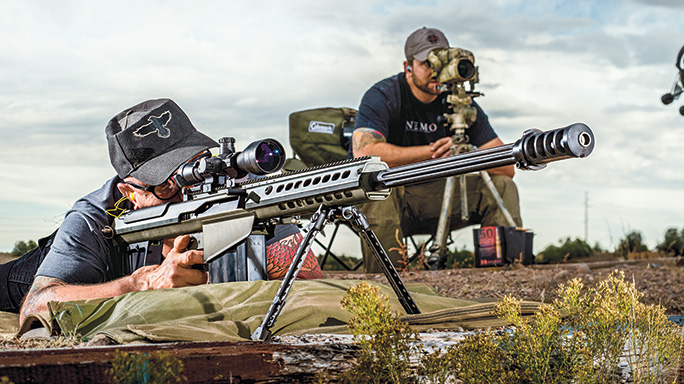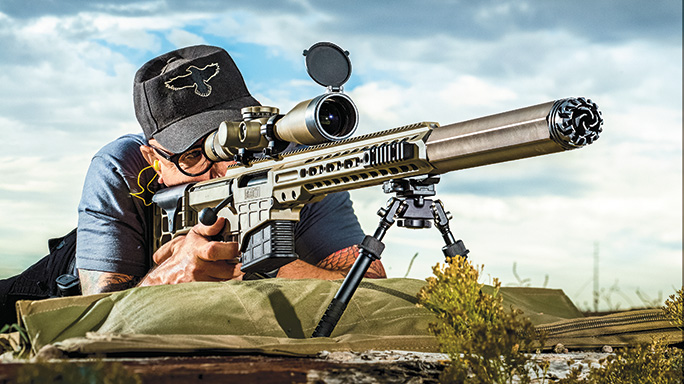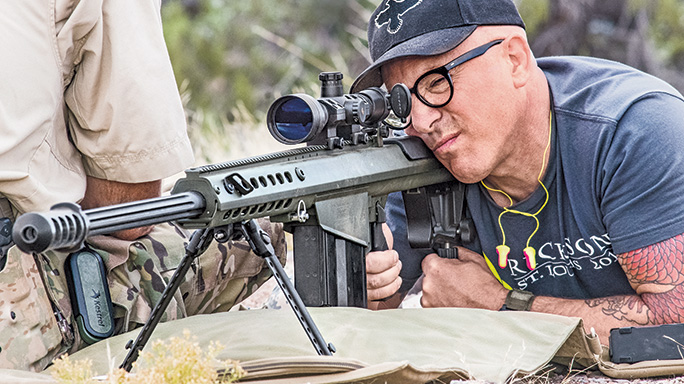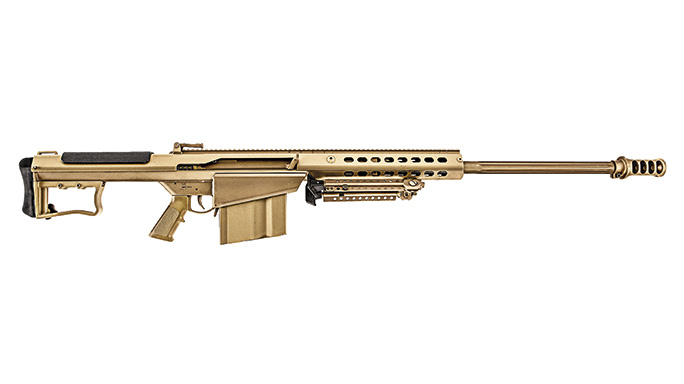He’s never been afraid of a challenge. Whether taking his Grammy-winning music career in new directions, scratching a vineyard and winery out of rocky Arizona hillsides or launching lead at steel targets a mile away, Maynard is game. On a return trip to Gunsite Academy just before the release of his band Puscifer’s new album, “Money Shot,” rocker Maynard James Keenan took a break from music and winemaking to go large and long with big-bore rifles in Paulson, Ariz.
Go Big Or Go Home
Like most gun enthusiasts, Keenan harbored a curiosity and fascination with the .50 BMG. Few other calibers capture the imagination of shooters like the .50. Originally built in 1921 for the M2, or “Ma Deuce,” machine gun as a greatly scaled-up .30-06 cartridge, the .50 BMG has seen action in every major U.S. military conflict since its introduction. The M2 platform has been adapted to aircraft, tanks and armored personnel carriers, and in Vietnam, U.S. Marine Corps sniper Carlos Hathcock attached a telescopic sight to one and set the record for a long-distance kill at 2,286 yards. Today, DARPA and Lockheed Martin are said to be developing variants of the .50 BMG that will carry microprocessors and steering vanes that will allow the bullet to adjust its trajectory in flight.
Advertisement — Continue Reading Below
- RELATED VIDEO: Maynard James Keenan Rocks The .50
But the .50 BMG remained a largely crew-served and anti-materiel weapon until Ronnie Barrett, a photographer with no particular manufacturing experience, immersed himself in building a shoulder-fired version for civilian use. Initially turned down by several machine shops, Barrett managed to recruit a team of enthusiasts who worked on his project in their off hours. After selling a small number of units, the CIA purchased 100 of Barrett’s rifles for the Mujahideen in Afghanistan to fight the Soviet Union.
The U.S. Navy was the first adopter of the Barrett as an anti- materiel rifle, which found its way into multi-service line units, mostly explosive ordnance disposal (EOD) as a particularly effective method of BIP’ing explosives (destroying munitions at distance). The wide variety of rounds developed for the caliber, from standard ball to high-explosive incendiary armor-piercing (HEIAP), in the previous 70 years allowed for a multitude of applications at the individual and small-unit level.
Unstoppable M107A1
Advertisement — Continue Reading Below
Introduced in 1982, Barrett’s original .50 BMG, the M82, was a semi-auto anti-materiel rifle. Over the next 20 years, a small number of improvements and variants would appear, but the largest step forward was to the enhanced version known as the M107. Officially adopted as the “Long Range Sniper Rifle, Caliber .50, M107,” this version was similar to operate but featured a barrel assembly that absorbs the force of the recoil against large springs after each shot. Barrett updated the rifle to the M107A1 by reducing the overall weight of the semi-auto by 5 pounds and introducing a suppressor-ready, steel muzzle brake and aluminum recoil buffer system.
From a shooter’s standpoint, scaling up from small-caliber carbines to big-bore precision rifles is a massive step. With pistols and carbines, after the basic functions are mastered, proficiency is largely a matter of practice and a very basic understanding of ballistics to adjust for holdovers based upon the shooter’s visual estimation of the distance to the target. With precision rifles, optics, ballistics, weather, wind and range estimation all impact the shooter’s ability to get the round on target. Overlay those factors with the typical requirement of ranges restricting .50 BMG shooters to steel targets beyond 1,200 yards because of the damage the round inflicts on the steel and a shooter better have all of his of her skills aligned to even begin to enjoy the larger platform.
Luckily, Gunsite Academy had a National Champion .50 BMG shooter to get Keenan up to speed when it came time for him to run a Barrett M107A1. U.S. Army Special Forces Sergeant Major (retired) Walter Wilkinson served in the U.S. Army for 30 years, 26 of which were in special operations, before becoming a Gunsite instructor. “We are taking over two weeks of training and condensing it down to two days. It’s going to be a lot to digest,” Wilkinson said of the task of getting a recreational small-arms shooter dialed into a .50 BMG rifle.
Advertisement — Continue Reading Below
But Keenan adjusted to the challenge and rang the long-distance steel targets with regularity. The transition was no cakewalk, however, and Keenan got a taste of just how many elements come into play to get a shot on target at ranges beyond 1,000 meters.
“Some of the long-range hits were difficult to achieve. Sometimes it took me several shots. It made me want to know more about how to make that a consistent result. Lots to learn. But to really advance in this art, you need a partner—a spotter that can walk you through the variables that are too many to count. Just knowing your job isn’t enough to truly make your team effective,” Keenan said.
In addition to the M107A1, Keenan also ran a Barrett MRAD in .338 Lapua Magnum for this shoot, a lighter bolt-action precision rifle fitted with an Operators Suppressor Systems (OSS) BPR-1 suppressor. For ammo, he used Hornady’s match-grade, 750-grain A-MAX ammunition for the M107A1 and a mix of Hornady’s 285-grain boat-tail hollow-point (BTHP) match ammo and Barnes’ 280-grain LRX load for the bolt-action MRAD.
Advertisement — Continue Reading Below
Ringing Steel
From a physical standpoint, the Barrett .50 BMG is an imposing weapon to shoulder. First, it’s only realistically fired from the prone position, typically off a bipod or a similarly supported position. Though the weapon’s fully loaded weight of nearly 30 pounds diminishes the felt recoil, the impact of the muzzle blast is a sensory overload to most shooters. Even with ear and eye protection, the sound and overpressure are immense. To many, this enhances the appeal of the .50 BMG, but the fatigue caused by firing several rounds is always a factor and is particularly impactful to new shooters.
As with any precision rifle exercise, the process of getting a solid zero was the first order of the day. Keenan got to work the fundamentals of body position, trigger control and optics manipulation on paper targets and then adjusted to incremental known distances out to 500 yards. Wilkinson input the field adjustment data into his ballistic computer that derived a “trued” downrange velocity for the rifle and extrapolated adjustments for the much longer ranges to be shot on the following day.
Advertisement — Continue Reading Below
Keenan repeated the exercise with the Barrett MRAD in .338 Lapua Magnum. Comparatively, the MRAD was silky and quiet with its OSS suppressor and projectiles one-third the mass of the .50 BMG. Ironically, the .338 Lapua now holds the record for the longest confirmed kill, having edged out the previous record held by the .50 BMG by 50 yards. There is no doubt that both projectiles fly well, but the difference, however, is in the projectile’s mass and its impact on the target. For example, at 500 yards, the .50 BMG arrives with 9,403 foot-pounds of energy (fpe), compared to the .338 Lapua at 2,791 fpe. But don’t let the contrast fool you: The .338 Lapua has nearly the same impact energy at 500 yards that a 155-grain .308 round has at the muzzle.
Going The Distance
The second day brought greater challenges. We had the rare pleasure of being rained upon in Arizona. But greater than the rain was the wind that preceded it. Keenan got an object lesson in the impact of crosswinds on targets at long range. Gunsite Academy restricts the use of .50 BMGs on steel targets inside of 1,200 yards, so the majority of the shots were between 1,200 yards and the magical 1-mile mark of 1,760 yards.
Advertisement — Continue Reading Below
Much of consistent long-range shooting success depends upon the dialogue between the shooter and spotter. As wind gusts, temperatures vary and distances change, the shooter and spotter have to communicate in a clear shorthand where each word relays an understandable and executable adjustment to the shooter’s sight picture. If the spotter is unclear, or the shooter holds more or less than the spotter indicates, adjustments on follow-up shots will be skewed and inconsistent. But as an Army veteran, Keenan can follow orders, and he worked through several complex shooting solutions with Wilkinson on both the .50 BMG and .338 Lapua Magnum rifles.
Keenan became more comfortable with the optics and ballistics from one round to the next, and began to flow with the process. But to the newly converted, ranging distance and ringing steel becomes addictive. “You can’t just open a bag of licorice and expect to stop at one. Once you’ve opened it up, you gotta dig your fist back into that bag. Walt set the hook. I want more,” Keenan concluded.
For more, visit barrett.net or call 615-896-2938.
Advertisement — Continue Reading Below
Specifications Barrett M107A1
- CALIBER: .50 BMG
- BARREL: 20 or 29 inches
- OA LENGTH: 48 or 57 inches
- WEIGHT: 27.4 or 28.7 pounds (empty)
- STOCK: Aluminum upper/steel lower
- SIGHTS: Flip-up iron
- ACTION: Semi-auto
- FINISH: Cerakote
- CAPACITY: 10+1
- MSRP: $13,694 (as tested)
Specifications Barrett MRAD
- CALIBER: .338 Lapua Magnum
- BARREL: 24 inches
- OA LENGTH: 47 inches
- WEIGHT: 14.72 pounds (empty)
- STOCK: Folding
- SIGHTS: None
- ACTION: Bolt
- FINISH: Cerakote
- CAPACITY: 10+1
- MSRP: $6,154 (as tested)



























